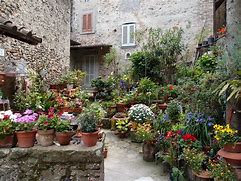If you have a patio and some indoor houseplants, you can create a beautiful and relaxing outdoor space by moving your plants outside for the summer. Not only will your plants enjoy the fresh air and sunshine, but you will also add some color and life to your patio. Here are some tips on how to set up a patio with indoor houseplants in pots.

Choose the Right Plants
Not all indoor houseplants are suitable for outdoor conditions. Some plants, such as cacti, succulents, ponytail palm, croton, hoya, amaryllis, ficus, coleus, caladiums, and begonias can tolerate or even thrive outdoors in the summer, as long as they are acclimated gradually . Other plants, such as orchids, philodendron, palms, fiddle-leaf figs, and pilea peperomioides (aka Chinese money plant) are more sensitive to temperature, humidity, and light changes and are best kept indoors.
Acclimate Your Plants
Before moving your plants outside, make sure the nighttime low temperature is consistently above 55°F (13°C) in your area²³. Then start by placing them in a shady spot outdoors for a few hours each day, and gradually increase the duration and brightness of their exposure over two weeks. Avoid direct sun at first, as it can burn their leaves. You can also mist your plants with water to help them adjust to the humidity levels outdoors.
Choose the Right Spot
Depending on your patio size and layout, you can arrange your plants in different ways to create interest and harmony. Group them by color, shape, size, or texture. Feel free to mix them with other outdoor plants or flowers for more variety. Make sure each plant receives the appropriate amount of light and shade for its needs. You can also use available railings or privacy walls to hang some plants or place them on shelves or stands. If you have a large patio, you can create different zones or focal points with your plants.
Choose the Right Pots
When moving your plants outside, make sure they are in pots that have drainage holes and are suitable for outdoor use. You can use decorative pots that match your patio style or theme, or choose a more eclectic mix for a bohemian vibe. Check out this fabulous tequila sunrise patio pot. You can also repot your plants into larger pots if they have outgrown their original ones. Make sure each pot has a saucer or tray underneath to catch excess water and protect your patio surface from stains.
Care for Your Patio Plants
Once your plants are outside, they will need more water and fertilizer than indoors due to higher temperatures, evaporation, and growth rates. Monitor your plants’ soil moisture and water them when the top inch feels dry. You may also need to increase the frequency and amount of fertilizer you apply, but be careful not to overdo it. Too much water or fertilizer can cause root rot, leaf burn, or nutrient toxicity. You will also need to check and treat your plants for pests often, as they are more exposed to insects and other pests outdoors than indoors. You can use natural remedies such as neem oil, insecticidal soap, or diatomaceous earth to control common pests such as aphids.

